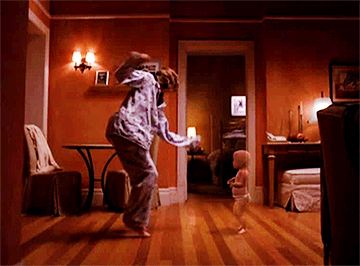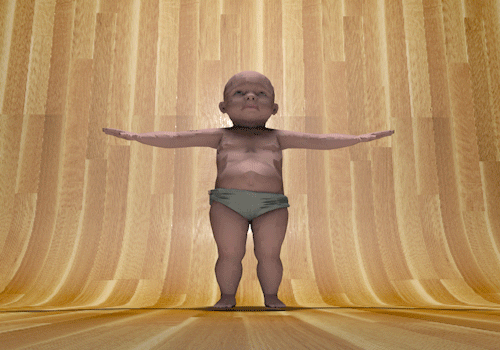Today is the 10th anniversary of Baby Cha-Cha a.k.a. the Dancing Baby a.k.a. Oogachaka Baby being uploaded to YouTube. Later this year will be the 20th anniversary of its creation by former LucasArts employees Ron Lussier, Michael Girard, and Robert Lurye. Baby Cha-Cha has had different trials than those a normal human child. Rather than baby’s first words, it had baby’s first television appearence (Ally McBeal), baby’s first commercial (Blockbuster), and baby’s first viral YouTube video.
Well, maybe that one is normal these days, but the point remains. A meme can never really grow up, lest it lose the meme-ness about itself. Despite the pungent dankness of meme culture these days, the entire media industry is still predicated toward the goal of virality, and there are few internet entities with Dancing Baby’s history and prestige (sorry, Clickhole!). What keeps a lowest-common-demoninator, 30-second loop ingrained in our minds and culture? “It plays on our base instincts of watchability,” explains Jamie Cohen, co-founder of the New Media program at Molloy College and author of Producing New and Digital Media: Your Guide to Savvy Use of the Web (Chapter 4 is about memes, and Chapter 5 is viral videos). “It’s part of the viral recipe of shareable media that hits us in the right spot.”
Videos by VICE
This is a simple version of the story that has been established internet lore / media theory for several years, and still applies to modern trending topics like “Hotline Bling.” Cohen’s job is to look at the different ways human beings regard things we care about as technology and culture advance. Right now, he’s working on a paper with collaborator Matt Applegate contrasting the rise of Pepe the Frog with the advent of Minions as a visual language. “I hate saying expert with this stuff because everyone is an expert, but I actually do get paid to research the weird shit on the internet,” he says.
Much of Cohen’s research (a.k.a., the internet) is predicated on the process of virality, which many trace back to Dancing Baby. We checked in with Cohen to learn about the history of meme ground zero, how the internet has changed since 1996, and whether or not Dancing Baby could go viral today.

GIPHY
The Creators Project: When did you first see Baby Cha Cha? What went through your head?
Jamie Cohen: This is going to date me, but the first time I saw it was on Ally McBeal when I was watching it. I think I taped that episode and watched that part over and over. Something about it was alluring and rewatchable. I didn’t know about memes at the time, but I now know I was experiencing it. If you go to the link for an article about it in 1997 (p39), it was called “hilarious yet oddly disturbing.”
What do you think about when you watch it now?
I still think it’s amazing. It plays on our base instincts of watchability. It’s part of the viral recipe of shareable media* that hits us in the right spot. It’s cute, weird, and well paced for a visual meme. It still holds up, and in the Dawkins’ sense of the word, it affects us selfishly.
*In shareable media, things that go viral seem to have several traits: babies, baby animals, shock, breaks, reactions, surprise, and most importantly: emotional impact. In this case, we see this baby like Ally McBeal does – a play to our reproductive brain spot.
Can you give me a brief history of Baby Cha Cha’s spread through email in 1996?
Well. The web was weird in 1996. Only a handful of sites were capable of showing video at that point. The browser was only two years old. During this period, email sharing of highly compressed video and pictures was all the rage! It depended on on your ISP, but if you had Prodigy, Compuserve, or AOL, your inbox was full of terrible chain letters with attached images and short video files. They didn’t stream, you had to download it. At this time, some of the very first pre-YouTube virals were appearing in the file space—Angriest Man in the World (Winnebago Man), Little Superstar, Homestar Runner. People were even ripping America’s Funniest Videos to put online—AFV did have it figured out first, so that is obvious. The downside: It would take forever to download and a lot of servers were pissed when people sent video because it would bog the system. This is also why GIF, PNG, and Flash were booming at the time: they were small, fast, and built for screens.
How did it survive in the 10 years between it’s first taste of virality and being uploaded to a young YouTube in 2006?
Well, how did Winnebago Man survive from VHS, to .mpgs, to YouTube? The same way. Here’s the thing about memes and why they work: They exist in a space of our mind that replaces previous imagery and relationality to visual media. Simply put: You can’t ‘unsee’ things. According to scientists and scholars who study visual media and memes (Jenkins, Lanham, Vernallis, Shifman, etc…), memes exist in a selfish Dawkins way and also in a material way. The images, specifically the movement, sound, shape, burn into our mind. Take the drunk fighting octopus hook for example. Once someone shows you the image of the hook as fighting octopus, you will never be able to unsee that. (See also Pepsi chubby guy or FIFA facepalm.) It’s part of our survival mechanisms, but that goes way deep. So now, mix nostalgia, memory, sound recall, and a video repository and you get a repost of the original media. What’s great about the oldest Baby Cha-Cha (Oogachaka Baby from Issa-Ko’s Vids) is it shows that the quality of early YouTube was actually worse (!) than the quality of the original email file of Baby Cha Cha that was viral. Later it was uploaded again several times in higher quality when YT advanced.
What did the Baby Cha-Cha’s success mean for YouTube at the time?
Not much. YouTube had just launched officially two months previous. It’s first video hadn’t even been online a full year yet when Baby Cha-Cha was uploaded. It was actually the FOLLOWING day that YouTube got on the map. On Jan 16, somebody posted Jon Stewart on Crossfire from 2004 that had such repercussions as the Viacom lawsuit (like 700 million bucks or something), the cancellation of Crossfire (fuck those guys), and the eye of Sauron—*cough* Google—looking at YouTube as more than a video repository. The Baby Cha-Cha video does play a significant role, though! When people now made their way to the site, they realized YT was THE PLACE to find visual material of the memory. I remember showing my dad a Moody Blues music video that January and he was like “the quality is so shitty” and I was like: You wait—this will compete with TV soon. (I was right—take that dad!) I found Baby Cha-Cha again that summer and immediately remembered it from the decade previous. It has since survived in endlessly remixed memes and nostalgia kicks.
When did the trend of viewing Baby Cha-Cha as a source of nostalgia begin?
Immediately. The trend of watching Baby Cha-Cha or any commercial from the 90s or AFV videos began right away. That was the first wave of YouTube (pre-lawsuits and shit). It’s remixable because it’s a meme—that’s one of a memes traits. It’s oddness and cuteness mix keep it fresh with nostalgia. Then you get the weird late Gen Xers/early millenials (like me) who check it out just to remember and get the warm nostalgia feelings.
Could Baby Cha-Cha go viral today?
Maybe. This is hard to tell. Today, the meme and viral world is so strange. I think it’s possible, but more in a reactionary meme kind of way. Like if it were to exist in the same digital looping way, it would probably be posted by TheFatJewish or ShitHeadSteve or FuckJerry with like a “When you tryin to fit in at your [ur] parents party” type of caption. It would make its rounds through all the memelords and eventually make it to the dank memes sector like CabbageCatMemes and then fade back into nostalgia ad infinitum.
What about today’s viral content is different from classics like this?
Today’s stuff is very quick. Hard to make sticky. Today’s memes are highly referential. Because Baby Cha-Cha doesn’t really reference a source material or quote, it’s hard to see if it is sticky. What I mean by referential is that there’s an underlying fluency in the meme/viral world today that helps material go viral/memetic. If you get the reference, you can remix it over and over. We’ve moved beyond Lolcats, beyond Doge, now we are in another more image-based language of images that relies on the memory and referential shapes for the meaning. (Matt and I call it a homologlyphic language. We are presenting on this at the SCMS conference in Atlanta in March.) Today it’s important to use proper “grammar” on memes to make them work.
Is Baby Cha-Cha art?
Without a doubt Baby Cha-Cha is art. It’s beautiful.
Will we still remember it in another 20 years?
As long as we have our nostalgic memory and we are still alive we will definitely still remember it. It will mean less and less to younger crowds, but its odd, beautiful, artistic, quirkiness, will still be in our minds.

GIPHY
Keep up with Jamie Cohen over on the New Media at Molloy website, and read more about the specs and history of Dancing Baby here.
Related:
How Going Viral Has Changed Art
UCLA Students Explore Memes in the Modern Era
Go Behind The Scenes Of The Richard Dawkins Internet Meme Show
Your Favorite Memes Are Getting Turned Into Toys With A 3D Printer



